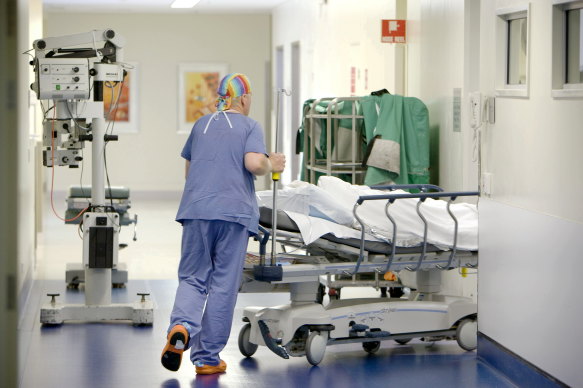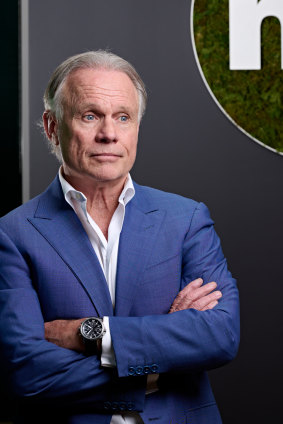This was published 10 months ago
Private health insurance premiums tipped to jump as claims rise
By Colin Kruger
Australia’s private health insurers may need to hit customers with a significant rise in premiums to meet the increasing number of claims, amid escalating tension with the struggling private hospital sector over funding for procedures.
Mark Fitzgibbon, the departing chief of NIB, one of Australia’s biggest health insurers, has warned that premium rises may need to return to pre-COVID-19 pandemic levels, with increases of up to six per cent, to cope with a pandemic recovery sparking a surge in customer claims for services such as elective surgery.

Private hospitals are closing, with operators saying their revenue from private health insurers is not keeping up with rising costs.Credit: Glenn Hunt
“Obviously, we hope that government policy is rational … [but] we may need premium increases above the long-run average, or at the long-run average at the very least,” Fitzgibbon said of the rises, which require federal government approval.
The average premium increase over the past decade is around 4.4 per cent. Analysts estimate the number of private health sector claims rose five per cent last year.
Fitzgibbon and his counterpart at Medibank, David Koczkar, were cautious about how these premium increases should be shared with the private hospital sector. Both see the sector as a crucial partner, but say it needs structural reform to reflect changes in healthcare.
“In terms of the longer-term outcome for hospitals, while we’re very sympathetic to the damage that COVID did to their balance sheets and P&L (profit and loss statement), there are some structural changes that they need to come to grips with,” Fitzgibbon said.
“For example, quite a profound shift away from keeping people in hospital for five days to more short-stay procedures.”
Koczkar told analysts at Medibank’s full-year results that the group reported 5 per cent fewer overnight procedures this year than five years ago, and the industry could not be expected to fund capacity that is not needed.
“Expecting consumers, insurers and governments to provide more funding for the status quo is not sustainable,” he said.

NIB chief executive Mark Fitzgibbon says a return to pre-pandemic premium increases for private health insurance is inevitable.Credit: Michael Quelch
The Australian Private Hospitals Association hit back on behalf of its members, saying even the recent bump in private hospital use has not helped as the dollar value of benefits has lagged rising costs.
APHA president Christine Gee said a 13.3 per cent growth in hospital treatment episodes between June 2019 and June 2024 yielded only a 5 per cent growth in income.
Private hospital operator Healthscope is about to begin a public campaign against private health insurers, saying they are refusing to fund the private hospitals fairly, and this puts Australia’s entire healthcare system at risk.
“Health insurers used to pay back on average 88¢ of every dollar they collected for hospital benefits. Now, Bupa only pays 81¢, and Australian Unity pays just 70¢,” Healthscope chief executive Greg Horan told staff in an email to announce the campaign.
“We are proudly standing up to these insurers.”
The campaign adds to the stakes for NIB, which needs a significant premium rise next year to ease investor concerns after the group’s full-year results sent its shares plunging last month.
This was triggered by its Australian business reporting that policyholder claims rose 5.7 per cent for the 2024 financial year, which is at the high end of management’s long-term guidance of 4 per cent to 6 per cent.
Last month, APRA reported that hospital treatment episodes rose 5.1 per cent in the 12 months to June 2024. This represented a 9.8 per cent rise since the March 2024 quarter.
The results signal the end of a golden era where the profit margins of private health insurers soared as Australians signed up for policies but delayed elective surgeries amid the aftermath of COVID-19.
Private health insurers were able to raise profit margins despite low premium increases.
Premiums rose by 3 per cent on average this year, 2.9 per cent in 2023 and 2.7 per cent in 2022, but this is now changing.
“During COVID people didn’t get to the dentist, they didn’t get to hospitals, elective care – and claims came right down,” Fitzgibbon said.
“We’re now in a period where inflation is high because the pipe is filling again, and with that, our margins are compressing just as we said they would.”
Citi’s Nigel Pittaway said NIB’s claims growth was above that of the rest of the sector, which is about 4.9 per cent, and warned of the looming federal election.
“Australian Resident Health Insurance claims inflation is now running above industry levels and the ability to bring it back in line with pricing could be hampered by the reality that the next pricing round at April 1, 2025, is likely to be close to a federal election,” Pittaway said.
At its full-year results last month, Medibank forecast its claims growth would be just 2.7 per cent due to economic conditions now impacting on claims.
Analysts say the NIB and Medibank figures are not easily compared due to the latter stripping out COVID impacts.
The Business Briefing newsletter delivers major stories, exclusive coverage and expert opinion. Sign up to get it every weekday morning.